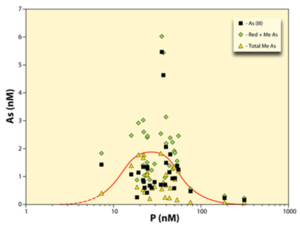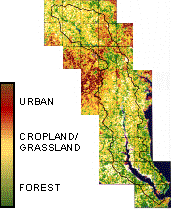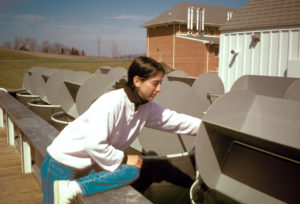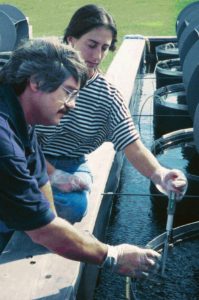Arsenic Biogeochemistry in Oceanic Surface Waters
The issue of phosphate limitation is a growing concern and highly topical, but also requires a consideration of arsenic cycling in these same waters. There are close geochemical and biochemical linkages between P and As cycling (see Figure) that suggest that in low phosphate waters, the products of As detoxification, reduced and methylated As, may act as indicators of the P-status of resident phytoplankton. Furthermore, under P stress or limitation, the differing abilities of phytoplankton species to detoxify As (“arsenic stress”) may influence the structure of the autotrophic community as has been demonstrated in coastal waters. With funding from the National Science Foundation, we used cultured isolates to help better define the linkage between the biogeochemistries of these two elements, and the role of As (and interactions with P) in the regulation of autotrophic communities in oceanic waters. The aim is to evaluate our hypotheses in the laboratory and then to apply them in the field.

A strong relationship exists between P concentration and the presence of reduced and methylated As forms in surface Sargasso Sea samples taken in 2003.
Selected background references:
Sanders, J.G. 1985. Arsenic geochemistry in Chesapeake Bay: dependence upon anthropogenic inputs and phytoplankton species composition. Mar. Chem. 17:329 340.
Sanders, J.G. 1986. Alteration of arsenic transport and reactivity in coastal marine systems after biological transformation. Rapp. P. v. Reun. Cons. int. Explor. Mer 186:185 192.
Sanders, J.G., G.F. Riedel and R.W. Osman. 1994. Arsenic cycling and impact in estuarine and coastal marine ecosystems. Pages 289-308 in: J.O. Nriagu, (ed.) Arsenic in the Environment, Part I: Cycling and Characterization. John Wiley and Sons, NY.
Riedel, G.F. and J.G. Sanders. 2003. The interrelationships among trace element cycling, nutrient loading, and system complexity in estuaries: A mesocosm study. Estuaries 26: 339-351.
The Importance of Understanding Ecological Complexity to Predicting Effects of Multiple Stressors on Coastal Systems (COASTES)

The Patuxent River, and surrounding land types
COASTES was a multidisciplinary program, funded by the National Oceanographic and Atmospheric Administration, designed to improve the understanding of the effects of multiple stressors in coastal systems and the role that the complexity of natural systems plays in influencing responses to anthropogenic stress. COASTES focused on the Patuxent River, a subestuary of the Chesapeake Bay, as a model ecosystem.
Funded by NOAA-Coastal Ocean Program, the multi-year (1995 — 2003), multi-investigator project had at its core an integrated team of watershed experts, ecologists, economists and managers who designed an integrated approach to the issue. By examining land use, ecology, fisheries, management issues, and economics in a coordinated effort, we insure that we will be able to integrate information generated to improve our scientific understanding and management of the estuary. Sanders served as co-Lead Investigator with Dr. Denise Breitburg (The Academy of Natural Sciences, Estuarine Research Center).

The COASTES mesocosms
In one phase of the project, scientists working at a range of scales from small microcosms to 1 m3 mesocosms to large outdoor field enclosures conducted experiments to:
- Determine the effects of multiple stressors on a representative estuarine system
- Examine how trophic complexity and temporal dynamics affect the way estuarine systems respond to stress
- Examine how redundancy and complementarity within trophic levels, and the complexity of feeding relationships, affect the way that estuarine systems respond to stress
- Determine how much of the complexity of ecological systems we need to incorporate in experimental systems and models in order to make sound management recommendations

Sampling for trace elements
Selected bibliography from the COASTES project:
Breitburg, D.L., J.G. Sanders, C.C. Gilmour, C.A. Hatfield, R.W. Osman, G.F. Riedel, S.P. Seitzinger, and K.G. Sellner. 1999. Variability in responses to nutrients and trace elements, and transmission of stressor effects through an estuarine food web. Limnol. Oceanogr. 44:837-863.
Riedel, G.F., S.A. Williams, G.S. Riedel, C.C. Gilmour and J.G. Sanders. 2000. Temporal and spatial patterns of trace elements in the Patuxent River: A whole watershed approach. Estuaries 23:521-535.
Laursen, A.E., S.P. Seitzinger, R. DeKorsey, J.G. Sanders, D.L. Breitburg, and R.W. Osman. 2002. Multiple stressors in an estuarine system: effects of nutrients, trace elements, and trophic complexity on benthic photosynthesis and respiration. Estuaries 25: 57-69.
D’Elia, C.F., W.R. Boynton and J.G. Sanders. 2003. A watershed perspective on nutrient enrichment, science and policy in the Patuxent River, Maryland: 1960-2000. Estuaries 26: 171-185.
Riedel, G.F. and J.G. Sanders. 2003. The interrelationships among trace element cycling, nutrient loading, and system complexity in estuaries: A mesocosm study. Estuaries 26: 339-351.
Riedel, G.F., J.G. Sanders, and D.L. Breitburg. 2003. Seasonal variability in response of estuarine phytoplankton communities to stress: Linkages between toxic trace elements and nutrient enrichment. Estuaries 26: 323-338.
Wiegener, T.N., S.P Seitzinger, D.L. Breitburg and J.G. Sanders. 2003. The effects of multiple stressors on the balance between autotrophic and heterotrophic processes in an estuarine system. Estuaries 26: 352-364.



